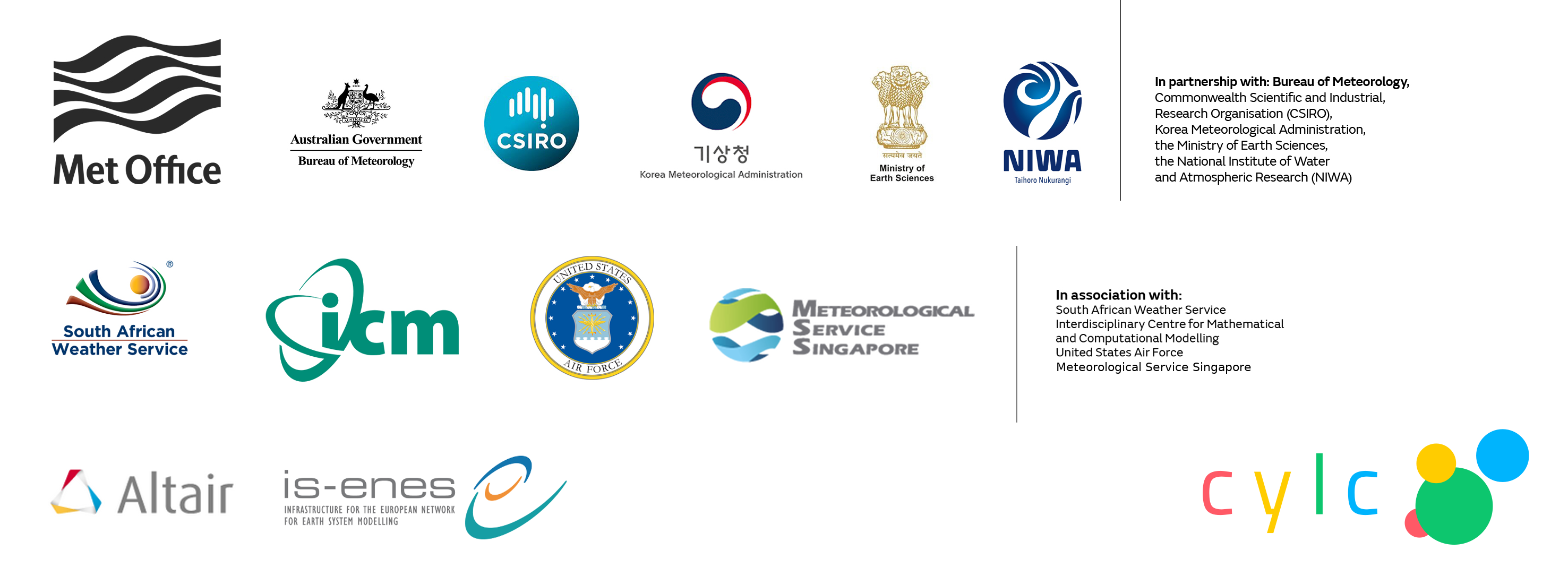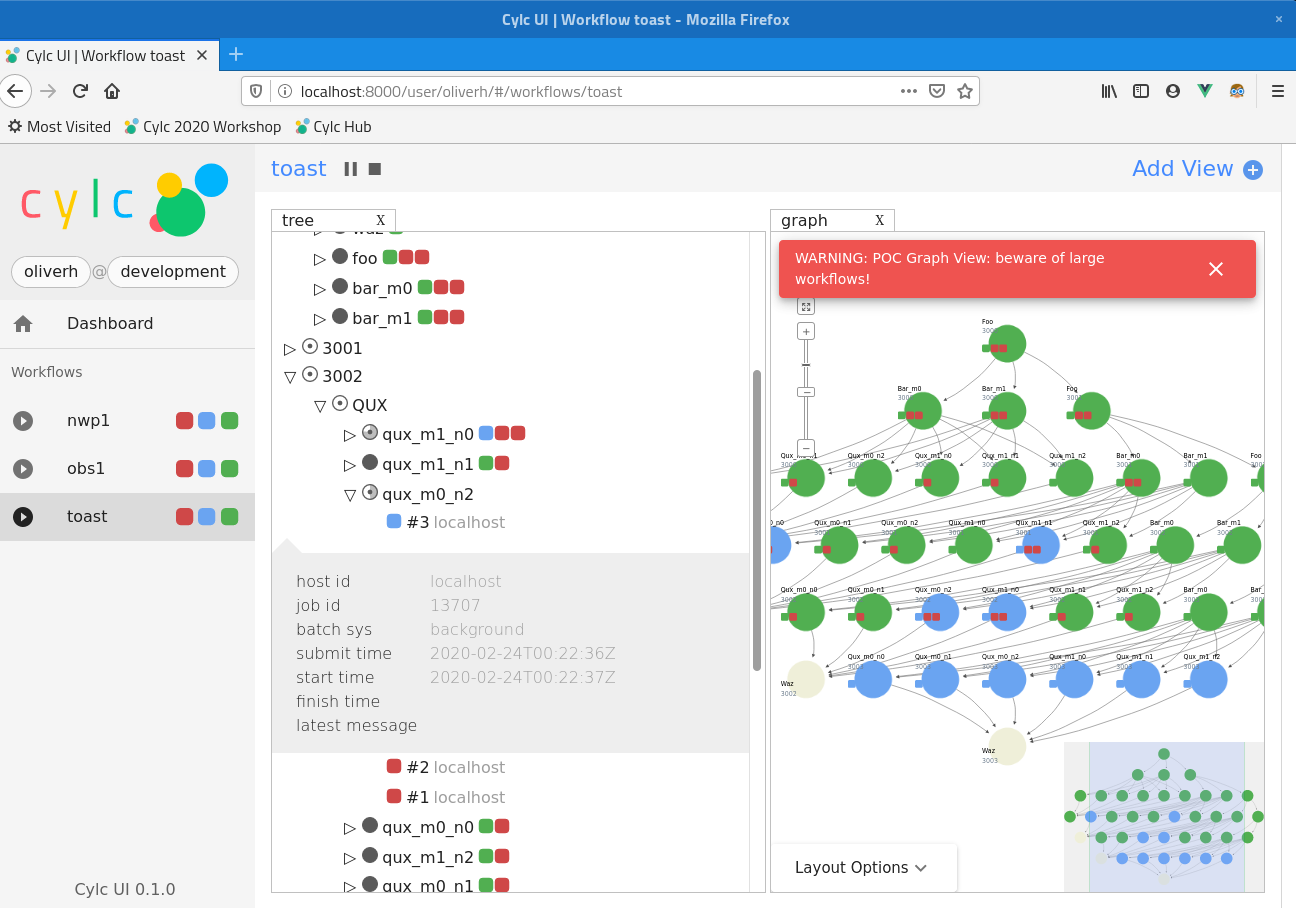cylc-admin

CylcCon 2020 Report
Cylc Development Workshop 10-14 Feb, NIWA, Wellington, New Zealand
Hilary Oliver, NIWA
Participants attended from NIWA, Met Office, BOM, and NRL.
Acknowledgement: Thanks to NIWA for hosting, and the UM Partnership and IS-ENES3 for funding travel for some participants.
Table of Contents
- Goal and topics
- Executive summary
- Progress to date
- Prioritization of remaining tasks
- Tentative development timeline
Goal and topics
The primary goal of the workshop was to review Cylc 8 progress and chart the roadmap to completion by early 2021.
For specific discussion topics covered during the workshop and links to relevant background material see the Workshop Agenda. For additional detail see workshop notes by HO and JR.
Executive summary
Python 2 end of life, obsoletion of the PyGTK GUI toolkit, and a near-universal modern preference for web UIs over traditional desktop GUIs, has led to an urgent need to re-engineer Cylc to future proof our investment in workflow orchestration.
The new Cylc 8 architecture was agreed during the December 2018 Cylc workshop at BOM. Much has been achieved since then despite some unexpected resourcing issues (staff turnover etc.). At this point the back-end workflow engine and CLI have been migrated to Python 3, and the major components Cylc 8 and the connections between them are all in place and working. It is already possible to run workflows of moderate size with Cylc 8 and view and control them in the new web UI. For details, see Progress to date below.
However, there is still much to do before Cylc 8 is production-ready. Every component needs detailing, extensive testing, and performance optimisation; and some important sub-systems are still missing. For example, the primary tree workflow status view does not yet perform well enough for large workflows; control functionality is not integrated with the view components; we don’t have efficient incremental data updates flowing through to the UI; some aspects of security have not been addressed; and we haven’t implemented fine-grained authorization yet. For details of what remains to be done, see Prioritization of remaining tasks.
We are aiming to have a major preview release of Cylc 8 ready for widespread testing in September of this year, and to officially release cylc-8.0 in the first quarter of 2021.
Progress to date
(First read the Executive summary.)
A recent screenshot of the new web UI showing live workflow data:

As of February 2020:
- The previously monolithic Cylc project has been split into multiple modular projects on GitHub (primarily because the UI is no longer Python based)
- Our new communications platforms Riot (developer chat and video conferencing) and Discourse (mail forum) are proving effective
- Web UI design settled after consultation with users (we anticipate more feedback during user testing)
- Packaging and installation is done, with
pipfor Python components andconda(via Conda Forge) for the full system - Major Cylc 8 components and connections implemented and working (but not
finished):
- Cylc Hub: the central point of access for user authentication, a JupyterHub instance configured to spawn Cylc UI Servers
- Cylc Flow (scheduler and CLI) fully migrated to Python 3
- Cylc UI Server: takes data from the workflow schedulers and
- Cylc web UI: the new Javascript (Vue.js) in-browser UI
- Scheduler to UI Server data pipe: Protocol Buffers over ZeroMQ
- UI Server to web UI data pipe: GraphQL over Websocket
- We are beginning to take advantage of new Python 3 features (e.g. entry points for extensibility via proper plug-ins)
- Much of the new web UI is implemented:
- The primary tree workflow status view is well on the way to completion
- The integrated gscan sidebar is working for live workflows
- The dashboard is ready to be populated with useful information
- Flexible tabbing of multiple workflow views is in place
- Control capability has been implemented in the web UI, but not integrated into the primary views yet.
- Back-end authentication (between CLI and workflow schedulers) is mostly done
Prioritization of remaining tasks
(First read the Executive summary.)
The following items were thoroughly discussed, and problems worked out, in the workshop. Now they just need to be implemented or completed.
Essential for Cylc 8.0
- Do we go ahead with Spawn on Demand?
- If yes: SoD solves many problems of efficiency and usage, but needs n-distance windowing to show nodes beyond the scheduler task pool
- If no: we probably need to replicate the Cylc 7 task pool window and continue to live with its many deficiencies until Cylc 9
- Event-driven incremental data update throughout the system
- Do we stick with the flat shared UI data store plan or allow views to request their own data in the form they need via GraphQL?
- Complete task state name rationalisation throughout the system
- Performant virtual-scrolling UI tree view
- Integration of control functionality in the UI (currently available via a special “mutations view”)
- Display (in the UI) held and queued badges, retries and xtriggers, etc.
- Cross-user functionality: how to get this via the Hub and/or the UI?
- Authorization: configuration and implementation
- CLI - UI Server (for other-user workflows, and remote jobs)
- Platforms support and associated config changes (including config file names)
-
rose suite-runmigration - Restore “ssh messaging” via ssh tunnel with ZMQ
- Solve UI Server back-compatibility
- New
cylc runcommand names and semantics, and “run1/2/3…” run directories - Workflow view window
- If spawn-on-submit: the scheduler task pool and ghost nodes, as now
- If spawn-on-demand: n-distance window, with n=0 as the scheduler pool
- (plus option to show whole cycles in SoS or SoD)
-
cylc review(Rose Bush) functionality:- contingency: make the old Python 2.7 system compatible with Cylc 8
- preferably: integrate with the new UI (but must be as convenient to use as the old system for historical data)
- Review User Guide and tutorials for Cylc 8
- New UI User Guide (in the UI)
- Document use of central
cylcwrapper with Cylc 8 - Document security-related aspects of the new architecture (including Hub-proxy comms)
Nice to have for Cylc 8.0
These can be bumped to 8.1 if necessary, but we’ll do as much as we can to get them done before then:
- Graph view conforming to our common design requirements
- Probably requires dagre layout + custom display engine
- Current window, and n edges around selected tasks by request
- Dot view (concise view of spread over cycle points)
- Flat table view (to allow sorting by job parameters such as submit time)
- Selection sharing/linking between views
- Display command progress (not just “command queued”)
- Consider load balancing with multiple UI Servers (just use current
cylc runmechanism?) - Minimal data stores (UIS should just store what is subscribed to, not the whole scheduler pool)
- Scheduler main loop refactor: asyncio co-routines
- User Preferences via the Hub
- Consider “pre-graph” tasks for file installation
- Change “batch system handler” to “job runner”, and re-implement as plugins
- New Urwid
cylc monitor: if performant for big workflows- (Need to address Tim W’s objection to this)
- add control functionality
- Multi-user gscan (this goes beyond the cross-user functionality above)
- Cylc Hub as an entry point plugin of the UIS package (just J-Hub, but needs to pick up our config file automatically)
- Minimal install for job platforms
Cylc 8.1
- Finish off remaining main Cylc 8 items, including Nice to have for Cylc 8.0 (above)
- Other workflow views (Gantt, Quilt, …)
- Allow starting the UI in read-only mode with deliberate escalation required for execute and read-write mode
- …
- Begin Cylc 9 development
Tentative development timeline
The following are endpoints to aim for, for the major tasks. (Smaller tasks above are not listed here as they can be fitted in around the bigger ones as time allows). Many of these items are already in progress or have at least been planned in advance. Initials have been given for those leading the development, but others may also be involved, and we have to be flexible depending on availability.
- March 2020:
- flat shared UI data store decision (OS, BK)
- April 2020:
- spawn-on-demand decision (HO, DM, OS)
- performant tree view with virtual scrolling (BK)
- incremental data update (DS)
- complete spawn-on-demand, if agreed, e.g. adapt the test battery (HO)
- May 2020:
- UI integrated control functionality (BK, OS)
- Complete remaining UI design elements - xtriggers etc. (BK, OS)
- June 2020:
- platforms support and config changes (TP, MH)
- authorization at the UI Server (HO)
- thoroughly document security (JR)
- July 2020:
- UI Server access to historical data within the view window (DS)
- cross-user functionality (BK, OS)
- August 2020:
-
rose suite-runmigration (TP, OS) including new run command semantics and run directory structure (HO) -
cylc reviewdecision - integration or contingency? (OS)
-
- September 2020:
- review and upgrade all documentation and training material (ALL)
- preview release on Conda Forge, encourage heavy testing

- October 2020-March 2021:
- address feedback, bugs, performance, stability (ALL)
- nice-to-have features, esp. the graph view
- March 2021 (or earlier):
- Cylc 8.0 major release

- Cylc 8.0 major release
- March-June 2021: continue to address feedback and bugs
- June 2021
- Cylc 8.1 with the remaining “Nice to have for Cylc 8” features
- July 2021 onward: Cylc 9 development (Python API etc.)
